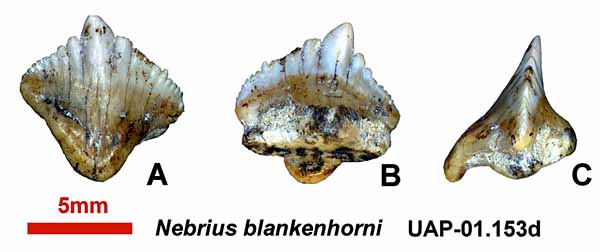†Nebrius blanckenhorni: Unterschied zwischen den Versionen
Aus WORLDFISH WIKI
Es (Diskussion | Beiträge) |
Es (Diskussion | Beiträge) (→Literatur) |
||
| (Eine dazwischenliegende Version desselben Benutzers wird nicht angezeigt) | |||
| Zeile 31: | Zeile 31: | ||
==Literatur== | ==Literatur== | ||
{{Stromer, 1903}}[ <span style="color: red">'''!!'''</span> als †''[[Ginglymostoma blanckenhorni]]''] | {{Stromer, 1903}}[ <span style="color: red">'''!!'''</span> als †''[[Ginglymostoma blanckenhorni]]''] | ||
| + | {{Stromer, 1905b}}[: 34, pl. 1, fig. 6, <span style="color: red; text-decoration: line-through;">†''Ginglymostoma blankenhorni''</span> -->†''[[Nebrius thielensi]]''] | ||
| + | {{Thurmond & Jones, 1981}}[: 45, fig. 11, <span style="color: red; text-decoration: line-through;">†''Ginglymostoma'' sp. cf. ''G. blankenhorni''</span> -->†''[[Nebrius thielensi]]''] | ||
{{Cappetta & Traverse, 1988}} | {{Cappetta & Traverse, 1988}} | ||
{{Cappetta, 2006}} | {{Cappetta, 2006}} | ||
{{Underwood et al., 2011a}} | {{Underwood et al., 2011a}} | ||
| − | + | {{Samonds et al., 2019}}[: 4, Fig 2A–2C, als *†''[[Nebrius blankenhorni]]''] | |
| − | {{Samonds et al., 2019}}[: 4, Fig 2A–2C, | ||
===Links=== | ===Links=== | ||
Aktuelle Version vom 11. Dezember 2019, 13:21 Uhr
(Stromer, 1903)
|
Familie: Ginglymostomatidae Synonyme†Ginglymostoma blanckenhorni Stromer, 1903
|
 †Nebrius blanckenhorni -- (C) Samonds, K.E., Andrianavalona, T.H., Wallett, L.A. Zalmout, I.S. & Ward, D.J. (2019) in PLoS ONE, 14 (2): e0211789. |
Typen
Holotypus: [[Type# .
Typusfundort: .
Etymologie
.
Verbreitung
Mittleres bis spätes Eozän Ägyptens, besonders häufig im späten Lutetium der Midawara-Formation in der Fayum Depression, westliche Wüste von Ägypten und im mittleren Eozän von Togo. Ebenso von Madagaskar.
Literatur
- Stromer, E. 1903. Haifischzähne aus dem unteren Mokattam bei Wasta in Egypten. Neues Jahrbuch für Mineralogie, Geologie und Paläontologie, 1: 29–41, 1 pl. Zitatseite [ !! als †Ginglymostoma blanckenhorni]
- Stromer, E. 1905. Die Fischreste des Mittleren und Oberen Eocäns von Ägypten. I. Teil, Selachii, B. Squaloidei und II. Teil, Teleostomi, A. Ganoidei. Beiträge zur Paläontologie und Geologie Österreich-Ungarns, 18: 163–185. Zitatseite [: 34, pl. 1, fig. 6, †Ginglymostoma blankenhorni -->†Nebrius thielensi]
- Thurmond, J.T. & Jones, D.E. 1981. Fossil vertebrates of Alabama. University of Alabama Press, 1981. Zitatseite [: 45, fig. 11, †Ginglymostoma sp. cf. G. blankenhorni -->†Nebrius thielensi]
- Cappetta, H. & Traverse, M. 1988. Une riche faune de sélaciens dans le bassin à phosphate de Kpogamé-Hahotoé (Éocène moyen du Togo): note préliminaire et précisions sur la structure et l’âge du gisement. Géobios, 21 (3): 359–365, 2 fig. Zitatseite
- Cappetta, H. (ed.) 2006. Elasmobranchii post-Triadici (Index specierum et generum). Leiden: Backhuys Publishers. Zitatseite
- Underwood, C.J., Ward, D.J., King, C., Antar, S.M., Zalmout, I.S. & Gingerich, P.D. 2011. Shark and ray faunas in the Middle and Late Eocene of the Fayum Area, Egypt. Proceedings of the Geologists’ Association, 122 (1): 47–66. Zitatseite
- Samonds, K.E., Andrianavalona, T.H., Wallett, L.A. Zalmout, I.S. & Ward, D.J. 2019. A middle - late Eocene neoselachian assemblage from nearshore marine deposits, Mahajanga Basin, northwestern Madagascar. PLoS ONE, 14 (2): e0211789. (doi) Zitatseite [: 4, Fig 2A–2C, als *†Nebrius blankenhorni]